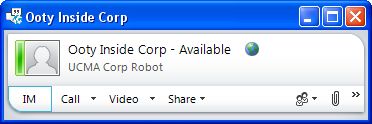As a follow up to my previous post about the syntax to initiate an IM or phone call from web page using standard HTML, I’ve gotten some questions on how to do other things in Lync via HTML like video and PC to PC calls. Not seeing any documentation on it, I used a utility called URLProtocolView to see what other commands besides tel: , sip:, and im: that were available to Lync (and Live Meeting) in a web browser –
| callto | Enabled | URL:CallTo Protocol | Microsoft Lync 2010 |
| conf | Enabled | URL:Conf Protocol | Microsoft Lync 2010 |
| im | Enabled | URL:IM Protocol | Microsoft Lync 2010 |
| sip | Enabled | URL:Sip Protocol | Microsoft Lync 2010 |
| sips | Enabled | URL:Sips Protocol | Microsoft Lync 2010 |
| tel | Enabled | URL:Tel Protocol | Microsoft Lync 2010 |
| meet | Enabled | URL:Meet Protocol | Microsoft Office Live Meeting 2007 |
Aside from the ones that I knew about, there is also callto: and conf:
What I also figured out from URLProtocolView is that when these are invoked in a HREF tag in a web browser, the web browser launches communicator.exe with a command line argument of what is contained in the tag. Searching for the communicator.exe command line arguments got me this for Lync 2010 on TechNet :
Lync 2010 Command-Line Parameters
| Extension | Format of Data | Action |
|---|---|---|
| tel: | tel URI | Opens the Conversation window for an audio call but does not dial the specified number. |
| callto: | tel:, sip:, or typeable tel URI | Opens the Conversation window for an audio call but does not dial the specified number. |
| sip: | SIP URI | Opens the Conversation window with the specified SIP Uniform Resource Identifier (URI) in the participant list. |
| Sips: | SIP URI | If Lync 2010 is configured to use the Transport Layer Security (TLS) protocol, functions exactly like sip:. If TLS is not being used, displays a dialog box informing the user that a higher level of security is required. |
| conf: | SIP URI of conference to join | If URI is self, instantiates the focus and brings up roster-only view. Otherwise, brings up roster view but does not send INVITE. |
| im: | SIP URI | Displays an instant messaging (IM)-only Conversation window with the SIP URI. Accepts multiple SIP URIs specified inside angle brackets (<>) without any separator. |
im:<sip:user1@host><sip:user2@host>
The following table provides examples of these command-line parameters.
Command-Line Parameter Examples
| Instance | Results |
|---|---|
| Tel:+14255550101 | Opens a phone-only view with +14255550101. |
| Callto:tel:+ 14255550101 | Opens a phone-only view with +14255550101. |
| Callto:sip:kazuto@litwareinc.com | Opens a phone-only view with kazuto@litwareinc.com. |
| sip:kazuto@litwareinc.com | Opens a Conversation window with kazuto@litwareinc.com. |
Hey, that looks the same as our list of protocols available, and they give examples to boot!
For example the behavior of callto: in this example:
<a href=”callto:sip:ootycorp@microsoft.com”>Click Here to Call</a>
Results in the contact to be pulled up like this:
but the call isn’t made, you still need to click to call or open the IM panel, which is not exactly what we were looking for but still useful.
So, given the information we have here it doesn’t look possible to do an automatic video call using this method, put putting in a SIP URI and then another click to pick the modality is possible.
Thanks,
Tom



Do we have any HTML URL Protocols to call a Distribution list in Lync 2010 ?